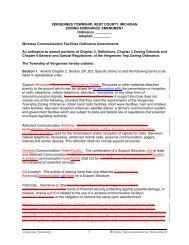The First One Hundred Years of Vergennes Township History
The First One Hundred Years of Vergennes Township History
The First One Hundred Years of Vergennes Township History
Create successful ePaper yourself
Turn your PDF publications into a flip-book with our unique Google optimized e-Paper software.
<strong>One</strong> <strong>of</strong> the settlers who did not remain in the background <strong>of</strong> <strong>Vergennes</strong> <strong>Township</strong>’s<br />
early history was Rodney Robinson. In 1836, the same year Sylvester Hodges settled in<br />
the township, Rodney Robinson came to this area and settled along the Flat River about<br />
one and a half miles north <strong>of</strong> Lowell. He was one <strong>of</strong> the 44 members <strong>of</strong> the Robinson<br />
Family, known as the “Robinson 44”, who settled all over Kent and Ottawa counties. In<br />
1838 when <strong>Vergennes</strong> <strong>Township</strong> was organized, Rodney Robinson was elected as the first<br />
township supervisor. v He was also the first postmaster <strong>of</strong> the Flat River post <strong>of</strong>fice. vi<br />
It is possible the post <strong>of</strong>fice was even in Robinson’s home, as was common it that era, or<br />
the <strong>of</strong>fice may have been in Lowell. Rodney Robinson’s involvement in <strong>Vergennes</strong><br />
<strong>Township</strong>’s history has earned him a place among its great founders.<br />
A third person who was very influential in the early history <strong>of</strong> <strong>Vergennes</strong> <strong>Township</strong><br />
was John Wesley Fallass from whom the village <strong>of</strong> Fallasburg received its name. Fallass<br />
came to West Michigan in 1837 at age <strong>of</strong> 25. In 1839, he bought a quarter <strong>of</strong> section 23.<br />
Also in 1839, he built a bridge across the Flat River at the place where the Fallasburg<br />
Covered Bridge is today (however, it was not a covered bridge). vii He also built that year,<br />
with the help <strong>of</strong> his brother Silas, a sawmill on the Flat River. In 1841, he established<br />
Fallasburgh ( the spelling was later changed to Fallasburg) By establishing Fallasburg,<br />
which will be explored further later in this paper, John Wesley Fallass left a lasting<br />
impact on <strong>Vergennes</strong> <strong>Township</strong>.<br />
It was the hard work, dedication, and perseverance <strong>of</strong> these pioneers that laid the<br />
foundation for the wonderful community <strong>Vergennes</strong> <strong>Township</strong> is today. Without people<br />
like Sylvester Hodges, Rodney Robinson, John Wesley Fallas, and many others, this<br />
township could not have been established. We owe much to those who pioneered<br />
<strong>Vergennes</strong> <strong>Township</strong>.<br />
Settlements<br />
Naturally, with settlers arriving in <strong>Vergennes</strong> <strong>Township</strong>, there were settlements that<br />
sprang up. <strong>The</strong>se villages provided the settlers with a chance to do their business locally<br />
as well as build a sense <strong>of</strong> community. Although all <strong>of</strong> these settlements are virtually<br />
deserted today, they were once important centers <strong>of</strong> commerce and social life for the people <strong>of</strong><br />
<strong>Vergennes</strong> <strong>Township</strong>.<br />
<strong>The</strong> most well-known, and perhaps the most important, <strong>of</strong> these settlements was<br />
Fallasburg. <strong>The</strong> history <strong>of</strong> Fallasburg begins with John Wesley Fallass and his brother<br />
Silas, who came to the area in 1837 and bought the land that would later become<br />
Fallasburg. In 1839, Fallasburg’s first business, a sawmill, was built by the<br />
Fallass brothers. viii Also in 1839, a bridge was built at the site <strong>of</strong> the Covered<br />
Bridge (as previously mentioned, it was not a covered bridge) In 1840, the Fallass<br />
brothers also built a grist mill on the Flat River near Fallasburg. However, Fallasburg<br />
didn’t really become a village until 1841 when the state road between Grand Rapids and<br />
Detroit was surveyed through it. ix Stagecoaches used the road, and this caused many businesses<br />
to spring up in Fallasburg, particularly travel related industries. In 1841,<br />
when John W. Fallass plotted the village, he laid out three parallel roads. Today, only




